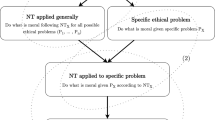Abstract
The doctrine of double effect (DDE) is a moral principle that distinguishes between harm we cause as a means to an end and harm that we cause as a side-effect. As a purely descriptive matter, the DDE is well established that it describes a consistent feature of human moral judgment. There are, however, several rival theories of its psychological cause. I review these theories and consider their advantages and disadvantages. Critically, most extant psychological theories of the DDE regard it as an accidental byproduct of cognitive architecture. This may provide philosophers with some reason to question its normative significance.
Similar content being viewed by others
References
Aquinas, T. (1988/1274). Summa Theologiae IIa IIae, Question 64, Article 7. In P. Sigmund (Ed.), St. Thomas Aquinas on Politics and Ethics. Norton, New York.
Chomsky, N. (1957). Syntactic Structures. The Hague: Mouton.
Chomsky, N. (1965). Aspects of the Theory of Syntax. Cambridge: MIT Press.
Crockett, M. J. (2013). Models of morality. Trends in Cognitive Science, 17 (8): 363–366.
Cushman, F. A., Young, L., & Hauser, M. D. (2006). The role of conscious reasoning and intuition in moral judgment: Testing three principles of harm. Psychological Science, 17 (12): 1082–1089.
Cushman, F. A. (2008). Crime and punishment: Distinguishing the roles of causal and intentional analyses in moral judgment. Cognition, 108 (2): 353–380.
Cushman, F. A., & Young, L. (2011). Patterns of moral judgment derive from nonmoral psychological representations. Cognitive Science, 35 (6): 1052–1075.
Cushman, F. A. (2013). Action, outcome and value: A dual-system framework for morality. Personality and Social Psychology Review, 17 (3): 273–292.
Dayan, P. (2012). How to set the switches on this thing. Current Opinion in Neurobiology, 22 (6): 1068–1074.
DeScioli, P., Asao, K., & Kurzban, R. (2012). Omissions and byproducts across moral domains. PLOS One, 7 (10): e46963.
Dickinson, A., Balleine, B., Watt, A., Gonzalez, F., & Boakes, R. A. (1995). Motivational control after extended instrumental training. Learning & Behavior, 23 (2): 197–206.
Dickinson, A., & Shanks, D. (1995). Instrumental action and causal representation. In D. Sperber, D. Premack & A. J. Premack (Eds.), Causal Cognition (pp. 5–25). Oxford: Oxford University Press.
Foot, P. (1967). The problem of abortion and the doctrine of double effect. Oxford Review, 5: 5–15.
Frank, M. J., & Badre, D. (2012). Mechanisms of hierarchical reinforcement learning in cortiostriatal circuits 1: computational analysis. Cerebral Cortex, 22 (3): 509–526.
Goldman, A. (1971). The individuation of action. Journal of Philosophy, 68: 761–774.
Greene, J. D., Sommerville, R. B., Nystrom, L. E., Darley, J. M., & Cohen, J. D. (2001). An fMRI investigation of emotional engagement in moral judgment. Science, 293: 2105–2108.
Greene, J. D. (2008). The Secret Joke of Kant’s Soul. In W. Sinnott-Armstrong (Ed.), Moral Psychology (Vol. 3). Cambridge, MA: MIT Press.
Greene, J. D., Cushman, F. A., Stewart, L. E., Lowenberg, K., Nystrom, L. E., & Cohen, J. D. (2009). Pushing moral buttons: The interaction between personal force and intention in moral judgment. Cognition, 111 (3): 364–371.
Hauser, M. D., Cushman, F. A., Young, L., Jin, R., & Mikhail, J. (2007). A dissociation between moral judgment and justification. Mind and Language, 22 (1): 1–21.
Lashley, K. S. (1951). The problem of serial order in behavior. New York: Wiley.
Lotto, L., Manfrinati, A., & Sarlo, M. (2013). A New Set of Moral Dilemmas: Norms for Moral Acceptability, Decision Times, and Emotional Salience. Journal of Behavioral Decision Making, 27 (1): 57–65.
Mikhail, J. (2000). Rawls’ Linguistic Analogy: A study of the ‘generative grammar’ model of moral theory described by John Rawls in ‘A theory of justice’. (Doctoral Dissertation), Cornell University, Ithaca.
Mikhail, J. (2007). Universal moral grammar: Theory, evidence, and the future. Trends in Cognitive Science, 11 (4): 143–152.
Mikhail, J. (2011). Elements of Moral Cognition: Rawls’ Linguistic Analogy and the Cognitive Science of Moral and Legal Judgment. Cambridge: Cambridge University Press.
Miller, G. A. (1956). The magical number seven, plus or minus two: some limits on our capacity for processing information. Psychological Review, 63 (2): 81.
Miller, R., & Cushman, F. (2013). Aversive for me, wrong for you: first-person behavioral aversions underlie the moral condemnation of harm. Social and Personality Psychology Compass, 7 (10): 707–718.
O’Reilly, R. C., & Frank, M. J. (2006). Making working memory work: a computational model of learning in the prefrontal cortex and basal ganglia. Neural Computation, 18 (2): 283–328.
Ribas-Fernandes, J. Ú. J. F., Solway, A., Diuk, C., McGuire, J. T., Barto, A. G., Niv, Y., & Botvinick, M. M. (2011). A neural signature of hierarchical reinforcement learning. Neuron, 71 (2): 370–379.
Royzman, E., & Baron, J. (2002). The Preference for Indirect Harm. Social Justice Research, 15 (2): 165–184.
Schwitzgebel, E., & Cushman, F. A. (2012). Expertise in moral reasoning? Order effects on moral judgment in professional philosophers and non-philosophers. Mind and Language, 27 (2): 135–153.
Sinnott-Armstrong, W., Mallon, R., McCoy, T., & Hull, J. G. (2008). Intention, temporal order, and moral judgments. Mind & Language, 23 (1): 90–106.
Waldmann, M. R., & Dieterich, J. H. (2007). Throwing a bomb on a person versus throwing a person on a bomb: intervention myopia in moral intuitions. Psychological Science, 18 (3): 247–253.
Young, L., Cushman, F. A., Hauser, M. D., & Saxe, R. (2007). The neural basis of the interaction between theory of mind and moral judgment. Proceedings of the National Academy of Sciences, 104 (20): 8235–8240.
Acknowledgments
This research was supported by Grant N00014-13-1-0281 from the Office of Naval Research.
Author information
Authors and Affiliations
Corresponding author
Rights and permissions
About this article
Cite this article
Cushman, F. The Psychological Origins of the Doctrine of Double Effect. Criminal Law, Philosophy 10, 763–776 (2016). https://doi.org/10.1007/s11572-014-9334-1
Published:
Issue Date:
DOI: https://doi.org/10.1007/s11572-014-9334-1



